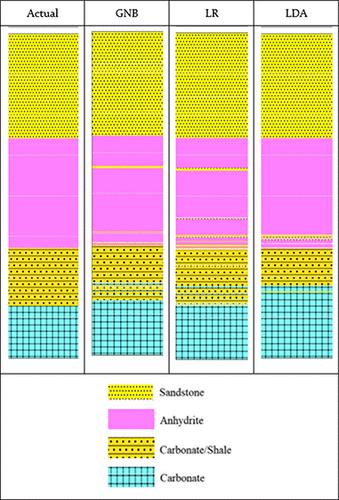Our official English website, www.x-mol.net, welcomes your feedback! (Note: you will need to create a separate account there.)
Applications of Different Classification Machine Learning Techniques to Predict Formation Tops and Lithology While Drilling
ACS Omega ( IF 3.7 ) Pub Date : 2023-10-30 , DOI: 10.1021/acsomega.3c03725 Ahmed Farid Ibrahim 1, 2 , Ashraf Ahmed 1 , Salaheldin Elkatatny 1, 2
ACS Omega ( IF 3.7 ) Pub Date : 2023-10-30 , DOI: 10.1021/acsomega.3c03725 Ahmed Farid Ibrahim 1, 2 , Ashraf Ahmed 1 , Salaheldin Elkatatny 1, 2
Affiliation

|
Accurate prediction of formation tops and lithology plays a critical role in optimizing drilling processes, cost reduction, and risk mitigation in hydrocarbon operations. Although several techniques like well logging, core sampling, cuttings analysis, seismic surveys, and mud logging are available for identifying formation tops, they have limitations such as high costs, lower accuracy, manpower-intensive processes, and time or depth lags that impede real-time estimation. Consequently, this study aims to leverage machine learning models based on easily accessible drilling parameters to predict formation tops and lithologies, overcoming the limitations associated with traditional methods. Data from two wells (A and B) in the Middle East, encompassing drilling mechanical parameters such as rate of penetration (ROP), drill string rotation (DSR), pumping rate (Q), standpipe pressure (SPP), weight on bit (WOB), and torque, were collected for real-field analysis. Machine learning models including Gaussian naive Bayes (GNB), logistic regression (LR), and linear discriminant analysis (LDA) were trained and tested on the data set from well A, while the data set from well B was utilized for model validation as unseen data. The formations of wells A and B consist of four lithologies, namely, sandstone, anhydrite, carbonate/shale, and carbonates, necessitating the development of multiclass classification models. The drilling parameters, specifically the WOB and ROP, exhibited a strong influence on lithology identification. Among the models, GNB demonstrated exceptional performance in predicting formation lithology from the drilling parameters, achieving accuracy and nearly perfect precision, recall, and F1 score for the different classes. LDA and LR models accurately predicted sandstone and carbonate lithologies, although some misclassifications occurred in approximately 5% of points for anhydrite and around 20% in carbonate/shale formations. During validation, the models demonstrated accuracies of around 0.96, 0.95, and 0.92 for the GNB, LR, and LDA, respectively. The study highlights the efficacy of the developed machine learning models in accurately predicting the formation lithology and tops in real time. This is achieved by utilizing readily available drilling parameters, making the approach highly accurate and cost effective by leveraging existing real-time drilling data.
中文翻译:

应用不同分类机器学习技术在钻井时预测地层顶部和岩性
准确预测地层顶部和岩性对于优化钻井工艺、降低成本和缓解碳氢化合物作业风险至关重要。尽管测井、岩心取样、岩屑分析、地震勘测和录井等多种技术可用于识别地层顶部,但它们存在成本高、精度较低、人力密集型过程以及时间或深度滞后等局限性,妨碍了真实地层顶部的识别。 -时间估计。因此,本研究旨在利用基于易于获取的钻井参数的机器学习模型来预测地层顶部和岩性,克服传统方法的局限性。来自中东两口井(A 和 B)的数据,包括钻井机械参数,例如钻速 (ROP)、钻柱旋转 (DSR)、抽油量 ( Q )、立管压力 (SPP)、钻压 (收集 WOB)和扭矩以进行现场分析。包括高斯朴素贝叶斯 (GNB)、逻辑回归 (LR) 和线性判别分析 (LDA) 在内的机器学习模型在 A 井的数据集上进行训练和测试,而 B 井的数据集则用于模型验证(如未见)数据。A 井和 B 井的地层由四种岩性组成,即砂岩、硬石膏、碳酸盐/页岩和碳酸盐岩,需要开发多类分类模型。钻井参数,特别是钻压和钻速,对岩性识别有很大影响。在这些模型中,GNB 在根据钻井参数预测地层岩性方面表现出了卓越的性能,在不同类别中实现了准确度和近乎完美的精确度、召回率和 F1 分数。LDA 和 LR 模型准确地预测了砂岩和碳酸盐岩岩性,但硬石膏中大约 5% 的点发生了一些错误分类,碳酸盐/页岩地层中大约 20% 的点发生了一些错误分类。在验证过程中,模型显示 GNB、LR 和 LDA 的准确度分别约为 0.96、0.95 和 0.92。该研究强调了所开发的机器学习模型在实时准确预测地层岩性和顶部方面的功效。这是通过利用现成的钻井参数来实现的,通过利用现有的实时钻井数据使该方法高度准确且具有成本效益。
更新日期:2023-10-30
中文翻译:

应用不同分类机器学习技术在钻井时预测地层顶部和岩性
准确预测地层顶部和岩性对于优化钻井工艺、降低成本和缓解碳氢化合物作业风险至关重要。尽管测井、岩心取样、岩屑分析、地震勘测和录井等多种技术可用于识别地层顶部,但它们存在成本高、精度较低、人力密集型过程以及时间或深度滞后等局限性,妨碍了真实地层顶部的识别。 -时间估计。因此,本研究旨在利用基于易于获取的钻井参数的机器学习模型来预测地层顶部和岩性,克服传统方法的局限性。来自中东两口井(A 和 B)的数据,包括钻井机械参数,例如钻速 (ROP)、钻柱旋转 (DSR)、抽油量 ( Q )、立管压力 (SPP)、钻压 (收集 WOB)和扭矩以进行现场分析。包括高斯朴素贝叶斯 (GNB)、逻辑回归 (LR) 和线性判别分析 (LDA) 在内的机器学习模型在 A 井的数据集上进行训练和测试,而 B 井的数据集则用于模型验证(如未见)数据。A 井和 B 井的地层由四种岩性组成,即砂岩、硬石膏、碳酸盐/页岩和碳酸盐岩,需要开发多类分类模型。钻井参数,特别是钻压和钻速,对岩性识别有很大影响。在这些模型中,GNB 在根据钻井参数预测地层岩性方面表现出了卓越的性能,在不同类别中实现了准确度和近乎完美的精确度、召回率和 F1 分数。LDA 和 LR 模型准确地预测了砂岩和碳酸盐岩岩性,但硬石膏中大约 5% 的点发生了一些错误分类,碳酸盐/页岩地层中大约 20% 的点发生了一些错误分类。在验证过程中,模型显示 GNB、LR 和 LDA 的准确度分别约为 0.96、0.95 和 0.92。该研究强调了所开发的机器学习模型在实时准确预测地层岩性和顶部方面的功效。这是通过利用现成的钻井参数来实现的,通过利用现有的实时钻井数据使该方法高度准确且具有成本效益。








































 京公网安备 11010802027423号
京公网安备 11010802027423号